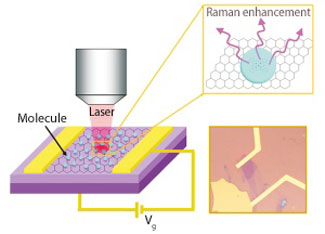| Oct 31, 2011 |
Graphene: Ramp up the Raman scattering
|
|
(Nanowerk News) Graphene exhibits exceptional electronic, mechanical, thermal and even optical properties, and for this reason scientists and developers are actively trying to find new and better ways of using this single layer of carbon atoms in devices. These same properties also make graphene useful as a tool for investigating the properties of other material systems using techniques such as surface-enhanced Raman spectroscopy. Jin Zhang and colleagues from Peking and Lanzhou universities in China have now demonstrated that graphene offers the possibility of tuning the intensity of the Raman signal ("Effect of Graphene Fermi Level on the Raman Scattering Intensity of Molecules on Graphene").
|
 |
| Schematic diagram of the experiment setup and an optical image of the graphene device (lower right). (© 2011 ACS)
|
|
Surface-enhanced Raman scattering occurs when a molecule is adsorbed and interacts with a conductive substrate. The Raman signal is useful because it provides detailed electromagnetic and chemical information on the molecular scale. On metal substrates, however, it has proved difficult to isolate the chemical signal. Zhang and his colleagues believed that they could resolve the chemical signal by using a graphene substrate and tuning the charge carrier concentration by applying a voltage — a process that shifts the electronic 'Fermi' level in the graphene and varies its alignment with critical energy levels in the adsorbed molecule.
|
|
Monitoring the Raman signal intensity while sweeping the applied voltage revealed a dramatic variation in the signal, but only when the voltage was swept rapidly (see image). The natural explanation for this is the well-known hysteresis exhibited by graphene during charging and discharging under an applied voltage, and the phenomenon corroborates the idea that there is a link between Raman intensity and the Fermi level in graphene.
|
|
The researchers also noticed that adsorbed molecules with a narrow bandgap showed a much more pronounced modulation. This is most likely due to the strong dependence of Raman intensity on charge transfer between the adsorbed molecules and the graphene, which is maximized when the Fermi level of graphene is aligned with the energy of the 'lowest unoccupied molecular orbital' in the molecule. If the bandgap is very large, it becomes difficult to bring the two levels close enough to produce strong modulation.
|
|
"We are now using this novel system to study this chemical enhancement further, which is difficult to observe using traditional metal substrates," says Zhang.
|

